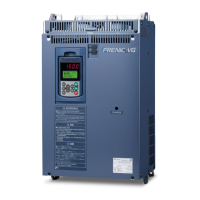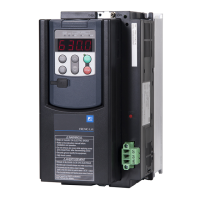2-4
2-3-2 Connecting the main circuit and grounding terminals
Table 2-3-1Functions of the main circuit terminals and grounding terminal
Terminal
marking
Name of terminal Description
P(+), N(-) DC link circuit terminals Connecting to the DC link circuit voltage of the inverter
P(+)R, DB
Connection terminals for
braking resistor
Connecting to the braking resistor
G Terminal for grounding DB unit
Grounding terminal of the chassis (case) of the DB unit
(1) DC link circuit terminals (P(+) and N(-))
① Connect the DC link circuit terminals P(+) and N(-) of the inverter to the terminals P(+) and N(-) of the
DB unit.
② Arrange the wire rout so that the wire length is less than 5m. Further, arrange the two wires to be twisted
or closely contacted (parallel) wiring.
③ Do not connect to an AC power supply.
(2) Connection terminals for braking resistor (P(+)R and DB)
① Connect the terminals P and DB of the braking resistor to the terminals P(+)R and DB of the DB unit.
② Arrange the wire rout so as the wire length is less than 10m. Further, arrange the two wires to be twisted
or closely contacted (parallel) wiring.
③ Do not connect to an AC power supply.
(3) Terminal for grounding DB unit ( G)
Ensure that the terminal G for grounding DB unit is grounded because of safety and countermeasure for
noise. To prevent disasters such as electric shock and fire, the Electric Facility Technical Standard specifies
on the grounding work for a metallic frame of electrical equipment.
Perform the connection as follows:
① In accordance with the Electric Facility Technical Standard, connect the terminal to a grounding pole
made by type D grounding for 200V series and to a grounding pole made by type C grounding for 400V
series.
② Use a suitable cable (thick and short) to connect the grounding terminal to the grounding pole specific
for the inverter system.
Table 2-3-2
Voltage
series
Sort of the grounding work
Grounding
resistance
200V Type D grounding
100Ωor less
400V Type C grounding
10Ω or less
CAUTION
・ Do not connect an AC power supply to the DC link circuit terminals (P(+) and
N(-)).
Damage may result.
・ Do not directly connect the braking resistor to the DC link circuit terminals (P(+)
and N(-)).
・ Check that the product specification complies with the inverter to be connected.
・ When the DB unit is damaged, the braking resistor may abnormally heated.
Make a sequence to interrupt the power supply on the inverter side by an alarm
signal.
Fire may result.

